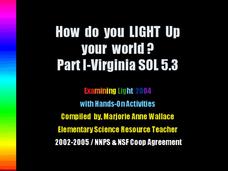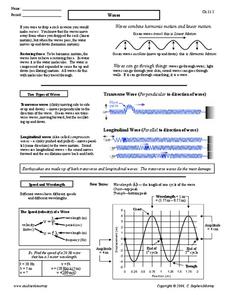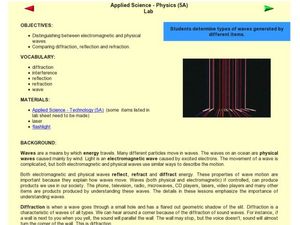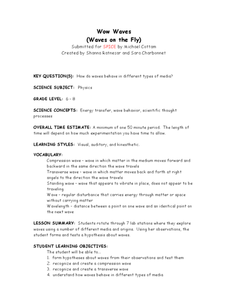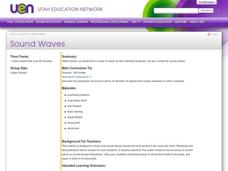Waves Teacher Resources
Find Waves lesson plans and worksheets
Showing 4,099 resources
Curated OER
Seeing and Feeling Sound Vibrations
Groups rotate through a series of stations and work with a partner to observe sound waves. Children describe sound in terms of pitch, volume, and frequency. To apply their new knowledge, the class considers how these observations can...
Curated OER
How Do You Light Up Your World?
A fabulous presentation on light is here for you. In it, learners view slides which cover many important concepts of light. They understand exactly what light is, what the main sources of light are, what opaque, transparent, and...
TED-Ed
What is Color?
"To understand the phenomenon of color, it helps to think about light as a wave." This is a brief and very informative instructional video on what color is and why we are able to see it. Your young scientists will learn such terms as the...
Exploratorium
Diffraction
Kindle knowledge of how light travels by using this activity in your physical science curriculum. By setting up a candle flame or flashlight bulb and viewing it through a slit, observers of light see evidence of its wave characteristic....
Curated OER
Waves
In this waves learning exercise, learners read about the different types of waves and how the speed of waves is calculated. Then students complete 5 matching, 8 fill in the blank, and 9 short answer questions.
Curated OER
Waves
In this waves worksheet, students read about harmonic and linear motion in waves as well as the two types of waves. They match 5 terms to their definitions about the structure of waves, they solve for the wavelength, frequency and...
Curated OER
Seismic Waves
In this seismic waves instructional activity, student will read information about the different types of waves that occur during an earthquake: P (Primary) waves, S (Secondary) waves, and shear waves. Then students will complete 2 short...
Curated OER
Waves Interference
Students identify different wave types and their characteristics. In this wave lesson students complete activities by activating tuning forks and interpreting data.
Curated OER
Electromagnetic and Physical Waves
Students compare and contrast electromagnetic and physical waves. For this wave lesson, students discover that all waves reflect, refract, and diffract energy. Students work in small groups to experiment with waves and evaluate the type...
Curated OER
Wave Superposition: Interactive On-line Mac and PC
Young scholars study definitions of wavelength, wave speed, wave amplitude, and wave period using an interactive JAVA environment. Distance and time are given so speed=wavelength/period can be verified or deduced by students. Waves...
Curated OER
Wow Waves (Waves on the Fly)
Students formulate hypotheses on wave behavior and test them. In this physics lesson, students compare and contrast transverse and compression waves. They determine the wavelength of transverse waves.
Curated OER
The Wonderful World of Waves (Wave Basics)
Young scholars define amplitude, wavelength, frequency, and period, calculate period given frequency, and calculate frequency given period, define crest and trough and locate both on diagram of wave, differentiate between latitudinal and...
Curated OER
Calculating Wave Speed
In this wave speed worksheet, students will learn how to calculate the speed of waves by dividing the wavelength by the period. Students will then calculate wave speed for 7 different examples.
Curated OER
Standing Waves
For this standing waves worksheet, students read about standing waves, their nodes, their anti-nodes and their wavelengths. They are given diagrams of harmonics and the equation to find the frequency of harmonics. Students match terms...
Curated OER
Characteristics of Waves
In this characteristics of waves worksheet, students answer 9 questions about the structure of waves, the types of waves and the components of waves. They describe the frequency of a wave and calculate the velocity and frequency of waves.
Curated OER
WAVES AND PHOTONS
Young scholars examine the many types of electromagnetic waves, the concept of an EM wave, how James Clerk Maxwell proposed a slight modification of the equations of electricity, Heinrich Hertz and his radio-frequency, wavelengths, and...
Curated OER
Fundamental Properties of a Wave
Young scholars investigate the form and motion of a wave, and examine the fundamental properties of wavelength, frequency, and amplitude. They discuss the fundamental properties of a wave, and in small groups conduct an experiment...
Curated OER
Sound Waves Simulation Worksheet
For this sound wave worksheet, students go to http://phet.colorado.edu/new/simulations/sims.php?sim=Sound and run the simulation to complete 28 short answer question.
Curated OER
Fetch Me a Wave
Students explore waves and how they form. In this wave instructional activity students prepare a written report on waves and tsunamis then discuss what they learned.
Curated OER
Sound Waves
Students observe how sound waves would look and behave if we could see them. They determine ways the model is accurate and inaccurate based on actual sound waves.
Curated OER
Riding the Radio Waves
Students examine the basic concepts of radio waves and magnetic fields. They study how the AM radios are built and demonstrate the concepts of amplitude and frequency.
Curated OER
Directing Sound Waves
Students learn that sound waves can be directed and collected. In this sound wave experiment, students create and collect sound waves. Students learn sound waves travel differently through different states of matter.
Khan Academy
How We Know About the Earth's Core
The big question is, how do we know about the composition of the earth's core? Sal explains that at 105 degrees from the source point of an earthquake, the phenomenon of the p wave shadow zone leads us to conclude that the waves are...
Curated OER
Reflection
Reflection is the bouncing of waves. Reflection can be used simply as entertainment or to guide ocean navigators. As your physics aces begin learning about waves, this resource would be valuable to show them that all of the different...
Other popular searches
- Sound Waves
- Light Waves
- Waves Physics
- Tidal Waves
- Light and Sound Waves
- Electromagnetic Waves
- Seismic Waves
- Ocean Waves
- Radio Waves
- Waves Powerpoint
- Properties of Waves
- Earthquake Waves



